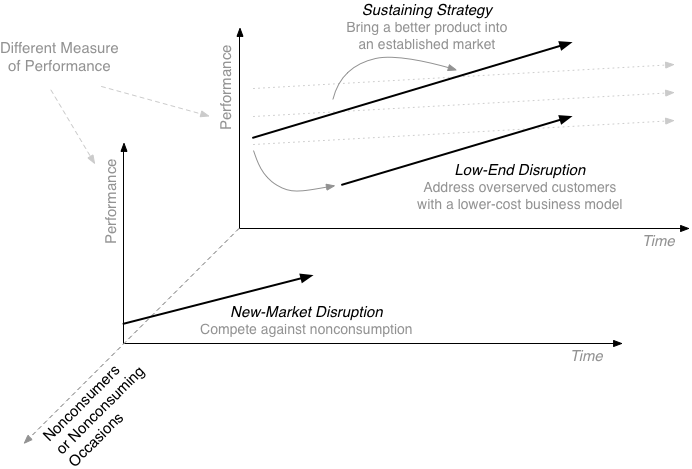Disruption and Web Applications, part 1
This article should give you quick overview of Clayton Christensen’s ground breaking book Innovator’s Solution and then I will try to apply his point onto the web application industry.
The Concept of Disruptive Innovation
Citing from the book:
Disruptive innovations … don’t attempt to bring better products to established customers in existing markets. Rather, they disrupt and redefine that trajectory by introducing products and services that are not as good as currently available products. But disruptive technologies offer other benefits–typically, they are simpler, more convenient, and less expensive products that appeal to new or less-demanding customers.
…Disruption has a paralyzing effect on industry leaders. With resource allocation processes designed and perfected to support sustaining innovations, they are constitutionally unable to respond. They are always motivated to go up-market, and almost never motivated to defend the new or low-end markets that the disruptors find attractive. We call this phenomenon asymmetric motivation.
You should definitely take a look at Innovator’s Solution, it’s great book and has more interesting concepts in it like the cycle between integration and modularization in an industry or the job to be done approach to business strategy.
I will introduce you to two key concepts of the book – low-end and new-market disruption.
Low-end Disruption
Low-end disruption, as described by Clayton, starts at the low end of the existing market. But the lower price is a result of new business processes not just lower margin on the same process employed by established market players.
One example of this strategy may be Walmart and other discount stores that offer their customers cheaper goods but compensate the lower margin via much larger amount of sold inventory and quicker turnover of inventory. So they may have lower margins than traditional stores, but they turn it over three times faster thereby more than making up for it. And then there are all the elaborate logistic things Walmart does, going so far as to direct their suppliers businesses in some ways.
Another example may be personal computers, which were low-end disruption relative to the mainframes. Or now the tablets (iPad) which are disrupting the PC.
The key is that there are overserved customers in the existing markets that are willing to let go of some features of the product in exchange for lower price, simplicity, convenience etc.
Established players are motivated not to fight with the new entrant as he is attacking the least earning portion of their business.

New-market Disruption
The target group of new-market disruption are non-consumers or non-consuming occasions. The disruptor is somehow able to transform existing product and get the new consumers.
Example might be the first transistor radios that were too low quality for the existing customers but were great for teenagers who were able to listen to what they wanted for the first time. And they allow everyone to listen on the go or outside home, which was impossible before.
The best thing from the point of view of the disruptor is that established market players ignore you for a long time because you are not eating their lunch. At least not for some time. And then it is too late for them.
OK, this was really quick and simplifying intro, again, read the book and/or watch the videos linked bellow.
In part 2, I will look at the implication of all this on the market of web applications.
Other sources
- Clayton Christensen speaking about Disruptive innovation Part 1 | Part 2 | Part 3 | Part 4
- Clayton Christensen interviewed by Charlie Rose
- Disruptive innovation fan video (no kidding)